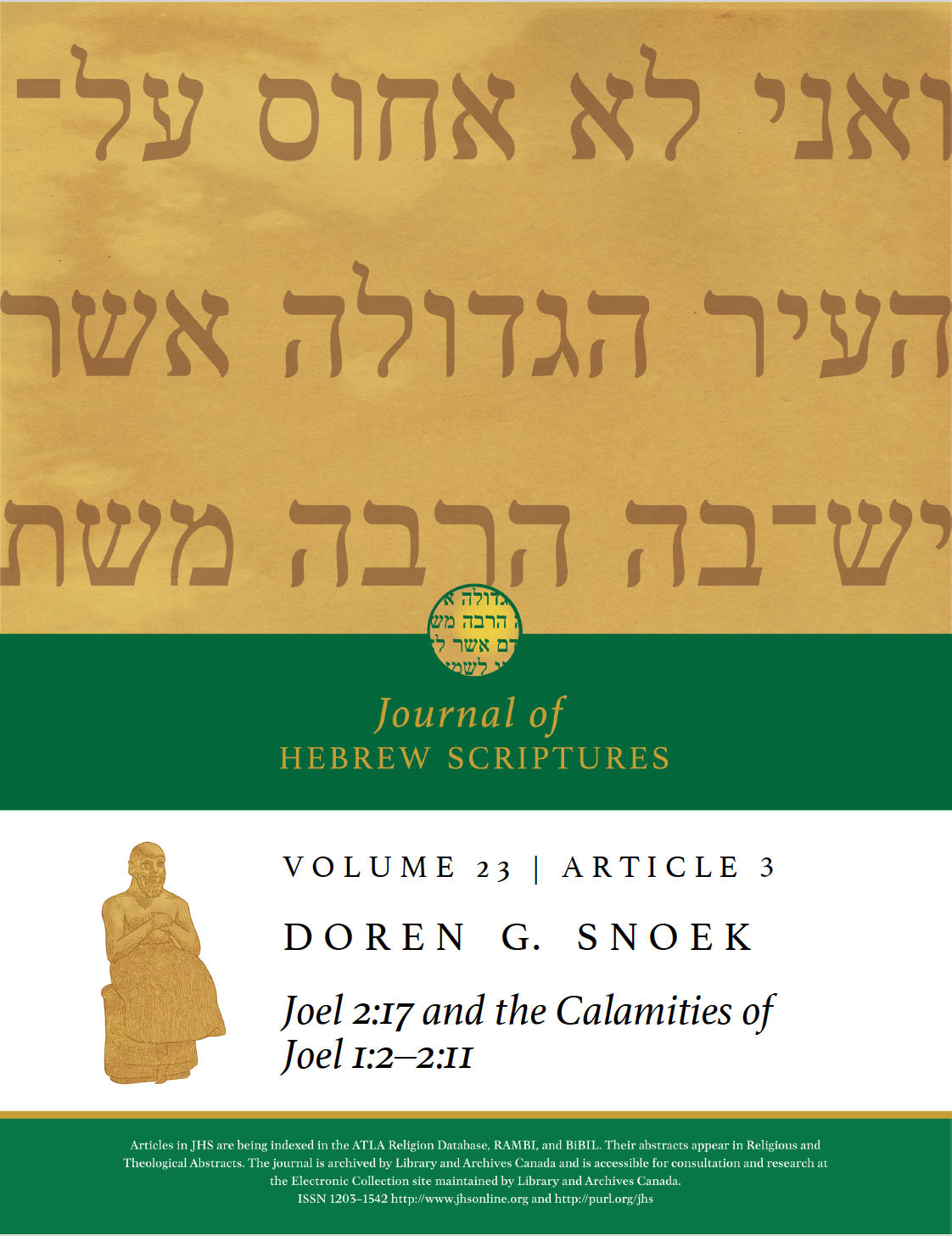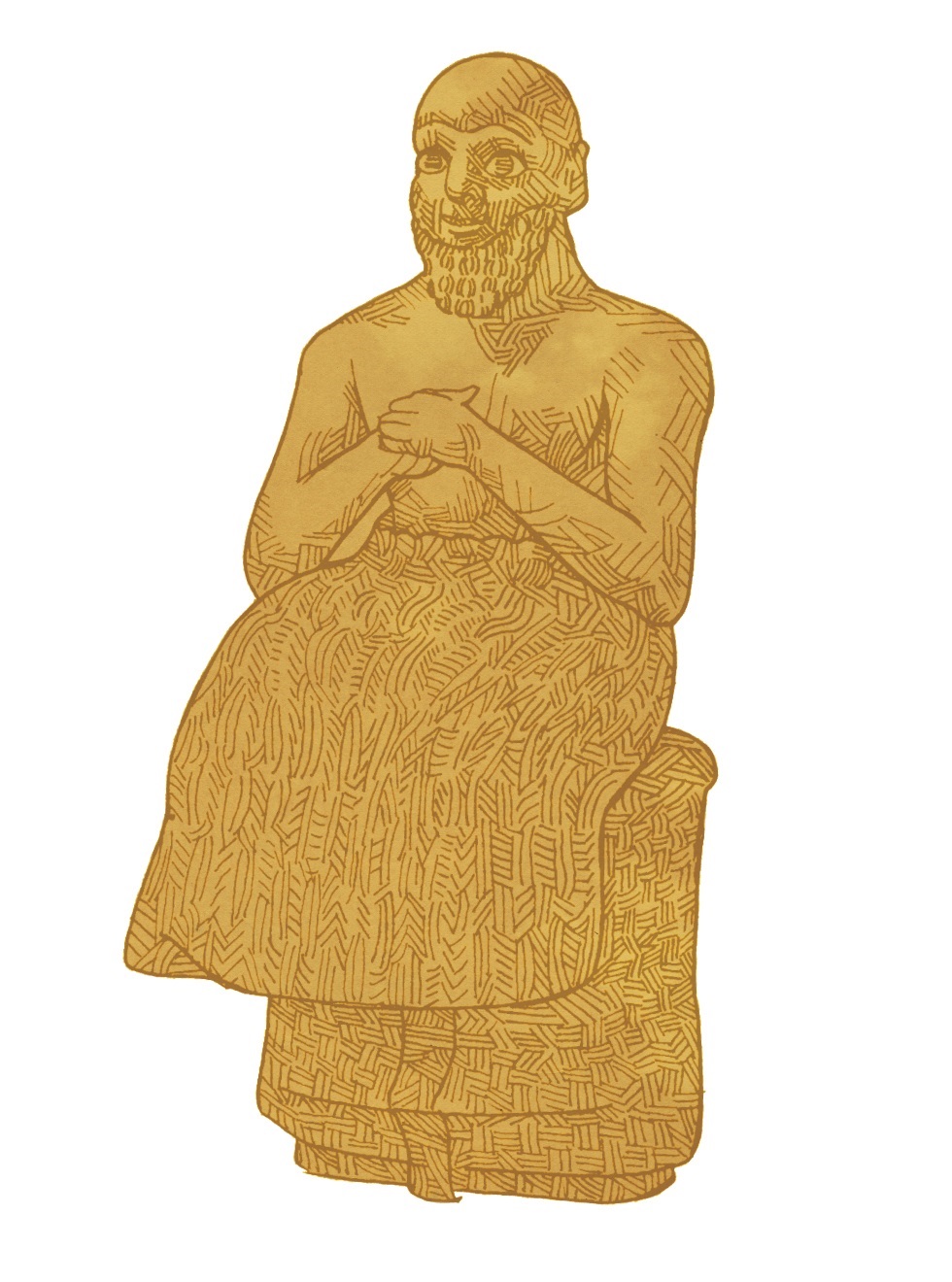Joel 2:17 and the Calamities of Joel 1:2-2:11
DOI:
https://doi.org/10.5508/jhs29601Keywords:
Joel 1-2, Joel 2:17, Wordplay, ParonomasiaAbstract
The relationship between the calamities of Joel 1:2-2:11 remains an unsettled problem. This article contributes to discussion of the problem by attending to what the speakers in the text envision as the outcome of those calamities. Joel 2:17 is proposed as an interpretive aid, and suggestions that the wording there is ambiguous or polysemous are examined; a close analysis of syntax there and of the valence of transformative נת״נ affirms the reading of the ancient versions over against claims of inclarity or wordplay. Although the locust plague is juxtaposed and metaphorically intermingled with the invading army, the text’s speakers at this point envision the outcome of the calamities not only as agricultural disaster but also as foreign domination. While in the text the agricultural disaster is a fait accompli, the second calamity may still be averted. The possibilities of agricultural restoration and foreign domination become literary goads; the addressees are spurred to act in their own self-interest, which is entangled with the deity’s.
References
Alter, Robert. The Art of Biblical Poetry. New York: Basic, 1985.
Andiñach, Pablo R. “The Locusts in the Message of Joel.” VT 42 (1992): 433–41.
Assis, Elie. The Book of Joel: A Prophet between Calamity and Hope. LHBOTS 581. New York; London: Bloomsbury, 2013.
Assis, Elie. “The Structure and Meaning of the Locust Plague Oracles in Joel 1,2–2,17.” ZAW 122 (2010): 401–16.
Baltzer, Klaus. Deutero-Jesaja. Vol. 2 of KAT 10. Gütersloh: Gütersloher Verlagshaus, 1999.
Barker, Joel. “One Good ‘Turn’ Deserves Another?” Pages 115–31 in Why?... How Long?: Studies on Voice(s) of Lamentation Rooted in Biblical Hebrew Poetry. Edited by LeAnn Snow Flesher, Carol J. Dempsey, and Mark J. Boda. LHBOTS 552. London; New York: Bloomsbury T&T Clark, 2014.
Barton, John. Joel and Obadiah: A Commentary. OTL. Louisville: Westminster John Knox Press, 2001.
Bauer, Hans and Pontus Leander. Historische Grammatik der hebräischen Sprache des alten Testamentes. Halle: Niemeyer, 1922.
Bergler, Siegfried. Joel als Schriftinterpret. BEATAJ 16. New York; Bern: Lang, 1987.
Blenkinsopp, Joseph. Isaiah 40-55: A New Translation with Introduction and Commentary. AB 19A. New York: Doubleday, 2002.
Bruce Waltke and Michael O’Connor. An Introduction to Biblical Hebrew Syntax. Winona Lake: Eisenbrauns, 1990.
Childs, Brevard S. “The Enemy from the North and the Chaos Tradition.” JBL 78 (1959): 187–98.
Crenshaw, James L. Joel. Vol. 24C of AB. New York: Doubleday, 1995.
Crenshaw, James L. “The Expression Mî Yôdea in the Hebrew Bible.” VT 36 (1986): 274–88.
Deist, Ferdinand E. “Parallels and Reinterpretation in the Book of Joel: A Theology of the Yom Yawhweh?” Pages 63–79 in Text and Context: Old Testament and Semitic Studies for F.C. Fensham. Edited by W. Claassen. JSOTSup 48. Sheffield: Academic Press, 1988.
Dobbs-Allsopp, F.W. On Biblical Poetry. New York: Oxford University Press, 2015.
Driver, Samuel R. The Books of Joel and Amos. Vol. 30–31 of CBC. 1897; repr. Cambridge: Cambridge University Press, 1898.
Duhm, Bernhard. “Anmerkungen zu den Zwölf Propheten.” ZAW 31 (1911): 161–204.
Emerton, J. A. “Are There Examples of Enclitic Mem in the Hebrew Bible?” Pages 117–35 in Studies on the Language and Literature of the Bible: Selected Works of J.A. Emerton. Edited by Graham Davies and Robert Gordon. VTSup 165. Leiden; Boston: Brill, 2015.
Gesenius, Wilhelm. Gesenius’ Hebrew Grammar. Edited by E. Kautzsch and A. E. Cowley. 2nd English ed. Oxford: Clarendon, 1910.
Hagedorn, Anselm C. Die Anderen im Spiegel: Israels Auseinandersetzung mit den Völkern in den Büchern Nahum, Zefanja, Obadja und Joel. BZAW 414. Berlin; Boston: de Gruyter, 2011.
Haney, Michael Lawrence. “Reading Joel as a Rhetorical-Therapeutic Response to Trauma.” PhD diss., Fuller Theological Seminary, 2019.
Hays, Rebecca Poe. “Divine Extortion and Mashal as a Polysemic Pivot: The Strategy of Complaint in Joel 2:12-17.” PRSt 42 (2015): 357–70.
Hermisson, Hans-Jürgen. Deuterojesaja. Vol. 2 of BKAT 11. Neukirchen-Vluyn: Neukirchener Verlag, 2003.
Hurowitz, Victor Avigdor. “Joel’s Locust Plague in Light of Sargon II’s Hymn to Nanaya.” JBL 112 (1993): 597–603.
Jeremias, Jörg. Die Propheten Joel, Obadja, Jona, Micha. Vol. 3 of ATD 24. Göttingen: Vandenhoeck & Ruprecht, 2007.
Jeremias, Jörg. Studien zum Dodekapropheton II: Gesammelte Aufsätze zu Joel, Obadja, Jona, Micha und Nahum. FAT 133. Tübingen: Mohr Siebeck, 2019.
Joüon, Paul, and Takamitsu Muraoka. A Grammar of Biblical Hebrew. Rome: Pontifical Biblical Institute, 2006.
Justi, Karl Wilhelm. Joel. Leipzig: Barth, 1820.
Kapelrud, Arvid S. Joel Studies. UUA 1948:4. Uppsala: Lundquist, 1948.
Khan, Geoffrey. Studies in Semitic Syntax. London Oriental Series 38. Oxford; New York: Oxford University Press, 1988.
Liddell, Henry George, and Robert Scott. A Greek-English Lexicon. Edited by Henry Stuart Jones and Roderick McKenzie. 9th ed., with A revised supplement. Oxford: Clarendon, 1996.
Linville, James R. “Letting the ‘Bi-Word’ ‘Rule’ in Joel 2:17.” JHebS 5 (2004): not paginated.
Mandelkern, Solomon. Concordance to the Tanakh. Revised ed. 2 vols. New York: Shulsinger Brothers, 1955.
Merx, Adalbert. Die Prophetie des Joel und ihre Ausleger. Halle: Waisenhaus, 1879.
Meshel, Naphtali S. “Too Much in the Sun: Intentional Ambiguity in the Samson Narrative.” HS 62 (2021): 55–72.
Milgrom, Jacob. Leviticus 1-16. Vol. 3 of AB. New York: Doubleday, 1991.
Müller, Anna Karena. Gottes Zukunft: die Möglichkeit der Rettung am Tag JHWHs nach dem Joelbuch. WMANT 119. Neukirchen: Neukirchener Verlag, 2008.
Muraoka, Takamitsu. A Greek-English Lexicon of the Septuagint. Revised ed. Leuven; Walpole: Peeters, 2009.
Noegel, Scott B. “Wordplay” in Ancient Near Eastern Texts. ANEM 26. Atlanta: SBL Press, 2021.
Nogalski, James. Redactional Processes in the Book of the Twelve. BZAW 218. Berlin; New York: de Gruyter, 1993.
Noll, Sonja. “Rereading Samuel’s Silence in 1 Samuel 7:8.” VT 66 (2016): 393–405.
Ogden, Graham S. “Joel 4 and Prophetic Responses to National Laments.” JSOT 26 (1983): 97–106.
del Olmo Lete, Gregorio. “The Postpositions in Semitic: The Case of Enclitic –m (with Special Attention to NWS).” AuOr 26 (2008): 25–59.
Pat-El, Na’ama. Studies in the Historical Syntax of Aramaic. Perspectives on Linguistics and Ancient Languages 1. Piscataway: Gorgias, 2012.
Robinson, Theodore H. Die zẅolf kleinen Propheten. HAT 14. Tübingen: Mohr Siebeck, 1938.
Seitz, Christopher R. Joel. ITC. London: Bloomsbury T&T Clark, 2016.
Sellin, D. Ernst. Das Zwölfprophetenbuch. KAT 12. Leipzig: Deichert, 1922.
Siebesma-Mannens, Femke. “Double Object Constructions in DSS Hebrew: The Case of ntn.” DSD 27 (2020): 372–91.
Simkins, Ronald A. “God, History, and the Natural World in the Book of Joel.” CBQ 55 (1993): 435–52.
Simkins, Ronald A. Yahweh’s Activity in History and Nature in the Book of Joel. Ancient Near Eastern Texts and Studies 10. Lewiston: Mellen, 1991.
Strazicich, John. Joel’s Use of Scripture and Scripture’s Use of Joel: Appropriation and Resignification in Second Temple Judaism and Early Christianity. BibInt 82. Leiden; Boston: Brill, 2007.
Thompson, John A. “Joel’s Locusts in the Light of Near Eastern Parallels.” JNES 14 (1955): 52–55.
Troxel, Ronald L. Joel: Scope, Genre(s), and Meaning. Critical Studies in the Hebrew Bible 6. Winona Lake: Eisenbrauns, 2015.
Troxel, Ronald L. “The Fate of Joel in the Redaction of the Twelve.” CurBR 13 (2015): 152–74.
Troxel, Ronald L. “The Problem of Time in Joel.” JBL 132 (2013): 77–95.
Van Grol, Harm. “Conflicting Structures in the Book of Joel and the Superficiality of the Book of the Twelve Prophets.” Pages 329–50 in The Books of the Twelve Prophets: Minor Prophets – Major Theologies. Edited by Heinz-Josef Fabry. BETL 195. Leuven; Paris; Bristol: Peeters, 2018.
Watson, Douglas William. “Let the Priests Lament: A Study of the Composition of the Book of Joel.” PhD diss., Emory University, 2013.
Watts, John D.W. The Books of Joel, Obadiah, Jonah, Nahum, Habakkuk, and Zephaniah. New York: Cambridge University Press, 1975.
Williams, Ronald J. Hebrew Syntax: An Outline. 2nd ed. Toronto; Buffalo: University of Toronto, 1976.
Wöhrle, Jakob. Die frühen Sammlungen des Zwölfprophetenbuches: Entstehung und Komposition. BZAW 360. Berlin; New York: de Gruyter, 2006.
Wolff, Hans Walter. Joel and Amos: A Commentary on the Books of the Prophets Joel and Amos. Translated by Janzen Waldemar. Hermeneia. Philadelphia: Fortress, 1977.
Yellin, David. “Paronomasia in the Bible / משׁנה־ההוראה בתנ״ך.” Tarbiz 5 (1933): 1–17.
Ziegler, Joseph. Duodecim Prophetae. Vol. 13 of Septuaginta: Vetus Testamentum Graecum. Göttingen: Vandenhoeck & Ruprecht, 1943.

Downloads
Published
How to Cite
Issue
Section
License
Copyright (c) 2024 Doren Snoek

This work is licensed under a Creative Commons Attribution 4.0 International License.

 Statue of Ebih-Il, drawing by Simeon Goa, © Journal of Hebrew Scriptures
Statue of Ebih-Il, drawing by Simeon Goa, © Journal of Hebrew Scriptures
